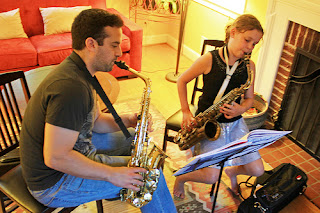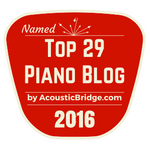One of the best ways to improve your musicianship is by taking the time to sing and actively listen to musical materials you use everyday. Let's consider our most basic chords, major and minor triads. These chords are made up of different combinations of major and minor thirds. A major third (M3) spans the distance of two whole steps (G-B); a minor third (m3) covers one-and-a-half steps (G-Bb).
You can construct those triads by using formulas: Major triad = M3 + m3; minor triad = m3 + M3 (spelled from the bottom up). If you know your major and minor scales, you can refer to these relationships between the degrees of the scale. Try the following exercises at the piano to review thirds and triads.
Using the numbers 1 2 3 4 5, sing the first five notes of a major scale starting on G. Check yourself on the piano. Next break the triad down into its two stacked thirds. Sing 1 2 3 and then leave out 2, singing 1-3 (G-B, a major 3rd). Next, sing 3 4 5, then just 3-5 (B-D, a minor third). Finally, sing 1 2 3 4 5, then 1-3-5. Congratulations! You have just sung a major triad (G-B-D).
Sing:
G-A-B-C-D
G-A-B
G-B (M3)
B, C, D
B, D (m3)
G-B-D (Major triad = M3 + m3)
For a minor triad, use the minor scale as your reference. Remember, a minor scale has a half step between sale degrees 2-3, so Bb is scale degree3 in G minor. Follow the same steps as above: 1 2 3 4 5. Then 1 2 3, 1-3, 3 4 5, 3-5. Finally, 12345: 1-3-5. Congratulations! You have just sung a minor triad (G-Bb-D). Do this same exercise starting on other notes within your voice range and you will improve your ability to quickly construct and recognize thirds and triads... by ear.
Hear and Play has just released a new software, Song Tutor and the Vocal Mastery System is a good resource for the vocalist/musician. Be sure and catch the following former posts I blogged about.
Ear Training
Ear Training Piano Lesson
Friday Freebie: Ear Training
Learn Songs By Ear
Practical Approach to Ear Training
Types of Ear Musicians
photo credit: Sunny Spot via photopin (license)
article credit: Joan Stiles
Blessings,
"The beautiful thing about learning is that no one can take it away from you." B.B.King

















![Validate my Atom 1.0 feed [Valid Atom 1.0]](valid-atom.png)







